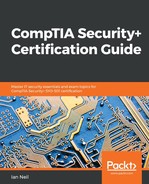The management team will create policies that need to be adhered to by all employees, and these policies are created to help reduce the risk to the business and are mandatory; failure to carry out these policies is called policy violation and may lead to disciplinary action:
- Policies: IT is immense, so if the management team says to the security administrators to go and set up IT security, the administrators would not know what to do, or where to start. Do they wish firewall rules to be set up, or permissions set on files?
If a policy was created so that Data Loss Prevention (DLP) templates were created to prevent Personally Identified Information (PII) or sensitive data being emailed out of the company, hen the Security Administrators would know exactly what to so.
The purpose of policies is to ensure that the security administrator knows what tasks they need to perform and also that end users know what their responsibilities are within each policy. Policies are an administrative control to help reduce risk.
- Least privilege policy: This policy states that access to data should be restricted and that employees should be given the minimum access required so that they can perform their job. In the military, it is known as the need to know principle, where if you don't need to know it, then you have no access.
- On-boarding policy: Companies allow employees to bring their own devices—Bring Your Own Device (BYOD)—to work, and part of the process is carrying out onboarding and offboarding. The on-boarding policy states that the device must be checked for viruses, and any application that could cause damage to the company's network should be removed before the device can be used to access the network. If someone brings their own device to work and fails to carry out the on-boarding properly, then the company could be infected by a virus.
- Off-boarding policy: When someone leaves your company, then the business data used on BYOD devices needs to be removed before departure. If off-boarding is not carried out properly, an ex-employee could leave with company data on their device.
- Acceptable Use Policy (AUP): The purpose of the AUP is to let the company employee or contractor know what they can do with company computers and BYOD devices. It lays out the practices on how you can access the company network and the internet. It will also state practices that are forbidden, such as participating in blogs and social media sites such as Facebook or Twitter while at work.
- Remote access policy: A remote access policy may state that when a remote user is connecting to the company's network, they must use a secure VPN such as L2TP/IPSec. Policy violation would be trying to connect by another method and lead to data being compromised.
- Auditing: The company employs an internal auditor to ensure that the employees carry out the policies and procedures written by the management team. The auditor does not have the authority to stop any processes, but they will report back to management. The outcome following an audit will result in change management or a policy being re-written.
The auditor is the snitch: they won't ever stop a process, but they always inform the management of non-compliance to company policies. The outcome following an audit will result in either change management or a new policy being written.
- Data-retention policy: For legal and compliance reasons, you may need to keep certain data for different periods of time; for example, some financial data needs to be retained for six years, whereas medical data may need to be kept for 20–30 years, depending on the type. A data-retention policy ensures that legal and compliance issues are addressed.
- Change management: Policies, procedures, and processes are in place so that the company is running efficiently and the risk is being managed properly; however, when newer technology is introduced, some of the procedures and processes may change. It could be that an auditor has identified a process that needs to change, so they report that to the manager, who will then adopt change management.
Change management requests are sent to a Change Management Board (CMB). The board looks at the change request, what the financial implications are, and how changing one process affects other processes. If the change is really major, then a new policy could be written rather than just change management.
Example: New laptops are being purchased and configured for use within the company. The auditor is reviewing the process and finds that there is no anti-virus software being installed on these laptops; therefore, they report this back to management. Management then looks at the processes that are laid down for configuring new laptops and then uses change management to change the processes so that in future anti-virus software is installed before rolling them out to the rest of the company.
